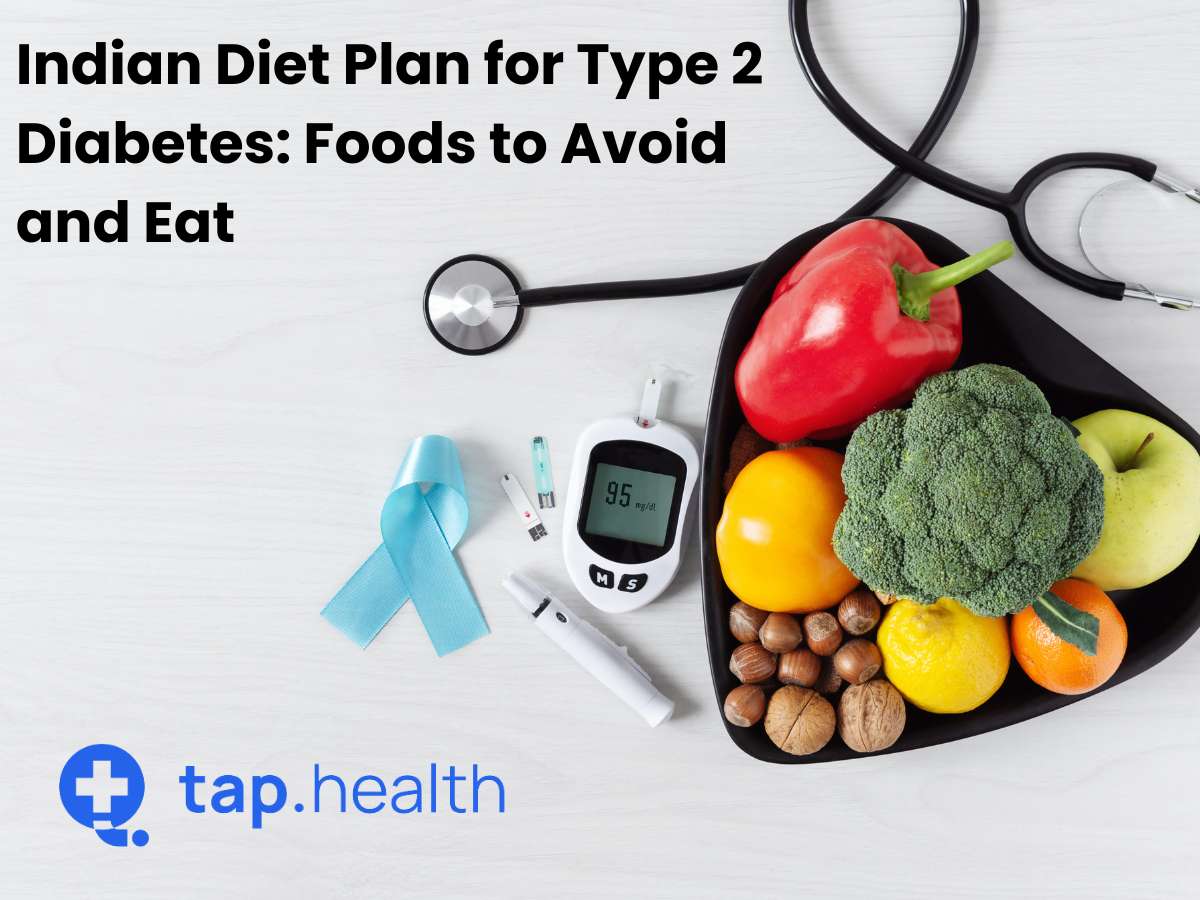Type 2 diabetes is a chronic condition affecting millions globally, characterized by high blood sugar levels due to insulin resistance or insufficient insulin production. While there’s no cure, lifestyle changes, particularly a balanced diet, can significantly help manage the condition. For those embracing Indian cuisine, a well-crafted Indian diet plan can stabilize blood sugar, improve insulin sensitivity, and reduce complications. This article provides a concise 7-day Indian diet plan for type 2 diabetes, highlights foods to eat and avoid, and explores natural ways to control the condition, all while incorporating traditional Indian flavors.
What is Type 2 Diabetes and How Does Diet Help?
Type 2 diabetes occurs when the body struggles to regulate blood sugar due to insulin resistance or low insulin production. Unlike type 1 diabetes, which is autoimmune, type 2 is heavily influenced by lifestyle factors like diet and physical activity. A healthy diet rich in whole foods, fiber, and low-glycemic ingredients can stabilize blood sugar levels, enhance insulin function, and reduce risks of complications like heart disease or nerve damage.
An Indian diet, rooted in whole grains, vegetables, legumes, and spices, is naturally suited for diabetes management. Spices like turmeric, cinnamon, and fenugreek, commonly used in Indian cooking, offer anti-inflammatory and blood sugar-lowering benefits, making them ideal for a diabetic-friendly diet.
Key Benefits of an Indian Diet for Type 2 Diabetes:
- High-fiber foods slow sugar absorption, preventing spikes.
- Spices like turmeric and cinnamon improve insulin sensitivity.
- Portion control aligns with traditional Indian meal practices.
7-Day Indian Diet Plan for Type 2 Diabetes
This 7-day Indian diet plan is designed to balance nutrition, flavor, and blood sugar control. It emphasizes low-glycemic, high-fiber foods and incorporates traditional Indian ingredients. Always consult a healthcare professional or dietitian before starting any new diet.
Day 1
- Breakfast: Vegetable upma (semolina with carrots, peas, and beans) + low-fat yogurt
- Lunch: Whole wheat roti + spinach dal + small portion of brown rice
- Evening Snack: Roasted chickpeas or a handful of almonds
- Dinner: Grilled chicken + mixed vegetable curry
Day 2
- Breakfast: Moong dal chilla (lentil pancake) + mint chutney
- Lunch: Quinoa vegetable pulao + cucumber raita
- Evening Snack: Steamed sprouts chaat with lemon and spices
- Dinner: Fish curry + steamed broccoli and carrots
Day 3
- Breakfast: Vegetable poha (flattened rice with veggies) + fresh orange juice
- Lunch: Bajra khichdi (pearl millet and lentils) + cucumber salad
- Evening Snack: Tomato and cucumber slices with hummus
- Dinner: Paneer tikka + mint-coriander chutney
Day 4
- Breakfast: Oats idli + coconut chutney
- Lunch: Whole wheat pasta with mixed vegetable sauce
- Evening Snack: Roasted makhana (fox nuts)
- Dinner: Egg curry + sautéed spinach
Day 5
- Breakfast: Ragi dosa (finger millet pancake) + sambar
- Lunch: Millet and vegetable pulao + curd
- Evening Snack: Fruit chaat with seasonal fruits and chaat masala
- Dinner: Tofu stir-fry + brown rice
Day 6
- Breakfast: Whole wheat toast with avocado and poached eggs
- Lunch: Lentil soup + roasted vegetables
- Evening Snack: Baked sweet potato wedges
- Dinner: Mushroom and broccoli stir-fry + quinoa
Day 7
- Breakfast: Multigrain porridge with a dash of honey
- Lunch: Barley and vegetable soup + grilled chicken
- Evening Snack: Greek yogurt with fresh berries
- Dinner: Spinach and cottage cheese curry + brown rice
This plan ensures variety, balanced nutrients, and controlled carbohydrate intake, making it suitable for managing type 2 diabetes while enjoying Indian flavors.
Foods to Eat for Type 2 Diabetes Management
Incorporating the right foods into your diet is crucial for controlling blood sugar and maintaining overall health. Here’s a list of diabetic-friendly foods ideal for an Indian diet:
- Whole Grains: Brown rice, quinoa, millet, and bajra provide fiber, slowing sugar absorption.
- Low-Glycemic Fruits: Berries, apples, and citrus fruits have minimal impact on blood sugar.
- Vegetables: Leafy greens, broccoli, and cauliflower are low in carbs and high in nutrients.
- Legumes and Pulses: Lentils, chickpeas, and kidney beans offer protein and fiber.
- Lean Proteins: Chicken, fish, tofu, and paneer support muscle health without spiking sugar.
- Healthy Fats: Nuts, seeds, and olive oil promote heart health.
- Hydration: Water, herbal teas, and coconut water keep you hydrated without added sugars.
Why These Foods Work: High-fiber and low-glycemic foods stabilize blood sugar, while lean proteins and healthy fats provide sustained energy and reduce cravings.
Foods to Avoid with Type 2 Diabetes
Certain foods can cause rapid blood sugar spikes or contribute to complications like high blood pressure. Here’s what to limit or avoid:
- Refined Grains: White rice, white bread, and regular pasta lack fiber and spike sugar levels.
- Sugary Foods: Sweets, desserts, and sweetened beverages like sodas or packaged juices.
- High-Sugar Fruits: Mangoes, bananas, and pineapples in excess due to high natural sugars.
- Processed Foods: Fried snacks, chips, and trans-fat-heavy foods harm heart health.
- High-Sodium Foods: Canned vegetables with added salt or salty snacks increase blood pressure.
- Alcohol and Caffeine: Excessive intake can disrupt blood sugar regulation.
Tip: Opt for whole, unprocessed foods and practice portion control to avoid sugar spikes.
Natural Ways to Control Type 2 Diabetes
In addition to a balanced diet, other lifestyle changes can enhance diabetes management:
- Regular Exercise: Engage in 30–60 minutes of aerobic exercises, strength training, or yoga daily to improve insulin sensitivity.
- Weight Management: Maintain a healthy weight through portion control and mindful eating.
- Stress Reduction: Practice meditation, deep breathing, or yoga to lower stress, which can affect blood sugar.
- Adequate Sleep: Aim for 7–8 hours of quality sleep to support metabolic health.
- Regular Monitoring: Check blood sugar levels regularly and consult healthcare providers for personalized advice.
Combining these habits with a diabetic-friendly Indian diet can significantly improve long-term health outcomes.
Why Spices Matter in a Diabetic Indian Diet
Indian spices like turmeric, cinnamon, and fenugreek are not just flavor enhancers but also have medicinal properties. Turmeric’s curcumin reduces inflammation and improves insulin sensitivity. Cinnamon helps lower fasting blood sugar, while fenugreek seeds slow carbohydrate absorption, preventing sugar spikes. Incorporating these spices into meals adds both health benefits and rich flavors.
Tips for Success with an Indian Diet for Diabetes
- Consult a Dietitian: Tailor the diet to your specific needs and medical conditions.
- Monitor Portions: Even healthy foods can affect blood sugar if eaten in large quantities.
- Stay Consistent: Follow the diet plan regularly for sustained benefits.
- Combine with Exercise: Pair the diet with physical activity for optimal results.
Conclusion
Managing type 2 diabetes with an Indian diet is both practical and effective, thanks to the cuisine’s emphasis on whole grains, vegetables, legumes, and beneficial spices. The 7-day Indian diet plan provided here offers a balanced, flavorful approach to stabilizing blood sugar while enjoying traditional meals. By choosing low-glycemic foods, avoiding processed and sugary items, and adopting healthy lifestyle habits like exercise and stress management, individuals can take control of their diabetes. Always consult a healthcare professional or dietitian to personalize your plan and ensure it aligns with your health goals.
FAQs: Indian Diet Plan for Type 2 Diabetes
What are the best foods for type 2 diabetes in an Indian diet?
Foods rich in fiber, low in refined carbs, and with a low glycemic index are best. Examples include whole grains (brown rice, millets, oats), vegetables, fruits (guava, apples, berries), legumes, and lean proteins (lentils, paneer, fish, eggs).
Which foods should diabetics avoid in an Indian diet?
Avoid foods high in sugar, refined flour (maida), fried snacks, sugary drinks, and processed foods. Examples include samosas, jalebi, soft drinks, white bread, and bakery items.
Can I eat rice if I have type 2 diabetes?
Yes, but choose brown rice, red rice, or millets instead of white rice, and keep portion sizes moderate to avoid blood sugar spikes.
Are Indian sweets completely off-limits for diabetics?
Sweets should be eaten very rarely. If you want, try sugar-free or low-sugar alternatives made from jaggery or natural sweeteners like stevia, but always in small quantities.
Is it safe to drink tea or coffee with diabetes?
Yes, but avoid adding too much sugar. You can use natural sweeteners and limit high-fat milk or cream. Green tea is also a good option.
How important is meal timing for managing type 2 diabetes?
Very important. Eating regular, balanced meals and snacks helps maintain stable blood sugar levels. Avoid skipping meals and try to eat at consistent times every day.
Can I eat fruits with diabetes?
Yes, choose fruits with low glycemic index like guava, apple, pear, and berries. Eat them in moderate portions, preferably with meals rather than alone.
Are nuts and seeds good for diabetics?
Yes, almonds, walnuts, flaxseeds, and chia seeds are excellent. They provide healthy fats, protein, and fiber, which help control blood sugar levels.
Should I avoid all carbohydrates?
No, carbohydrates are necessary for energy. Focus on complex carbs like whole grains, legumes, and vegetables instead of refined carbs and sugary foods.



